B3 Summer Institute Provides Interdisciplinary Training
August 28, 2012
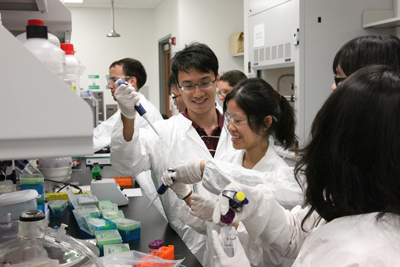
Institute participants from Taiwan enjoy working in a lab during one of the cellular and molecular biology modules.
"So it's a good two-week, very intense, but very "get-your-feet-wet" sort of experience that you achieve momentum. The speaker list is phenomenal...You name the campus, and you've got all the big leagues from anywhere, from this campus and other campuses all over." Irfan Ahmad
Nicknamed B3SI by the planners, the two-week-long BioSensing BioActuation BioNanotechnology Summer Institute 2012, held at the Micro and Nanotechnology Laboratory (MNTL) from July 30–August 10, 2012, was intended to train participants at the intersection of biology and engineering and to foster networking with other researchers. The three main sponsoring projects were the CMMB IGERT (Cellular and Molecular Mechanics and BioNanotechnology Integrative Graduate Education and Research Traineeship), the M-CNTC (Midwest Cancer Nanotechnology Training Center), and the BioSensing, BioActuation grant.
Rather than holding separate, possibly redundant institutes to provide their trainees the required hands-on lab components, the three projects offered a joint summer institute in 2012. Though other campus units helped sponsor the event, the three main funding agencies were the National Science Foundation, the National Institutes of Health, and the National Science Council of Taiwan.

Irfan Ahmad (right) discusses one of the institute participant's research during a poster session.
According to Irfan Ahmad, Executive Director of Illinois' Center for Nanoscale Science and Technology and Acting Assistant Dean for Research at the College of Engineering, the institute's primary goal was to expose participants, including those from minority-serving institutions and developing countries, to state-of-the-art techniques and resources they would not necessarily have access to.
Ahmad described the institute as a kind of "crash course" in multidisciplinary areas to help prepare the next generation workforce. "This is one of the ways to get a quick start to being exposed to a field totally alien to you, for which you have no or minimal preparation. So, if you are a biologist, you may not have taken any engineering courses, and you may not be familiar with the technical jargon in that and vice versa. So this would get your feet wet, and help lay the foundation for future multidisciplinary intellectual exchanges and research projects, leading toward developing a truly global B3 workforce for addressing overarching life sciences and engineering problems.”
"So we invite a biologist who talks about the basics of biology and of cancer biology so engineers who have not been exposed to biology would get familiar with the terminologies…For the engineers, it's a good primer, starting at the basic level, such as: 'What are lipids and enzymes?' 'What are the genetic basis for inheritance in organisms?' and 'How do you do cell culture?' And then we flip it. We also have faculty members from engineering talk about applied mechanics, micro and nanofabrication, and bioactuation/biosensing techniques and devices the biologists are not familiar with."
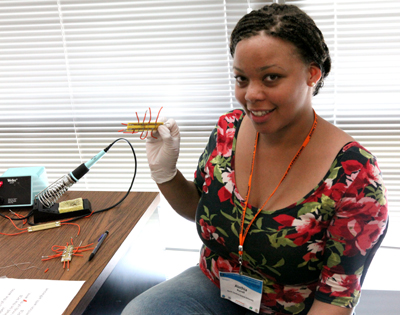
Participant displays a device she made during the microfluidics and enabling technologies module at the Micro and Nanotechnology Laboratory.
While most of the 51 participants were graduate students, there were a few junior faculty, undergrads, and even one high school student. Since the goal was to provide training at the interface of engineering and biology to foster interdisciplinary research, participants' disciplines varied widely, running the gamut from biology to chemistry to physics to engineering and pharmaceutical sciences.
Laura Miller, the program manager for the CMMB IGERT and M-CNTC, further emphasized interdisciplinary research: "That's what these traineeships are trying to spur on…To be able to work in this area of nanotechnology and medicine, you really have to be working at the interface of engineering and biology…Being in your own silo won't necessarily accomplish the research goals. You need to have an expertise in your area…but at the same time, be a well-rounded researcher."

Laura Sloofman and Hao-Ming Hsiao, one of the two Taiwan delegaton organizers who attended the institute.
This was the case for Laura Sloofman, an Illinois graduate student in Computational Biology and M-CNTC trainee working with Rashid Bashir to quantify the effects of mechanics on embryo differentiation. Not having taken traditional engineering courses, she found the institute to be very helpful.
"I think that, overall, they did a really, really good job. I think that it would be impossible to make everybody happy with every module. For the engineering modules, I really liked them, and the people who were in that field were kind of bored. But I had zero knowledge base about a lot of this stuff, and what I really liked is that, especially working with Rashid, I'm going to need to know how to do photolithography. I had zero concept of what that was. I knew I thought it was cool, but I had no idea how you go from a design of a microfluidic device to actually making one…Now I have a much better understanding about how to translate ideas to actual physical experiments, and I think that probably was the point, so 'Well done!'"
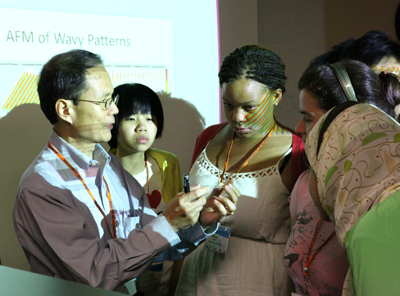
Jimmy Hsia gives trainees a chance to examine an instrument close-up.
Sloofman alluded to the fact that participants with expertise in a given field might find the introductory module in their field to be rudimentary. According to Miller, institute planners intended that rather than "skipping" the sessions on their own disciplines, participants "attend and help those that were less familiar with those kinds of techniques. For example, we wanted the people who were more familiar with biology to still attend the cell biology lab modules so they could help the engineers."
Regarding the technical training, did participants learn something more than they had known before? Were the lab modules useful to them? Was it intense enough to actually, according to Miller, "get them tired at the end of the day?" Based on conversations she had with students, the answers to all of those questions were: "Yes." She also indicated that participants were positive about the lectures; they were happy that faculty "didn't just lecture about their research then leave" but were engaged with them and welcomed discussion.
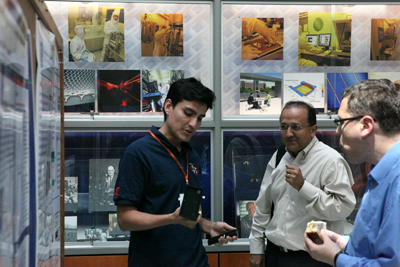
Dustin Gallegos (left) and Rashid Bashir (center) have a discussion during a poster presentation.
Another goal was to foster networking and relationship building among participants. "We really wanted this to be a time where participants make research collaborations that will last throughout their careers," shared Miller. "We hope that this is the environment where collaboration can begin...that they will continue to communicate with each other even after B3SI is over, and continue to use these materials and videos to advance their research."
Dustin Gallegos, an Illinois electrical engineering undergrad concentrating in biosensors, places himself "in the intersection of bioengineering and computer/electrical engineering, with an entrepreneurial inclination." He attended the institute to become more knowledgeable about the biology side of things and to network: "Even though I had taken a couple of classes in micro-biology in the past, I thought that there was still a lot for me to learn in the biological side of biosensors. So I saw this as a good opportunity to fill these knowledge "holes," as well as to have hands-on practice and to meet people interested in the same field."
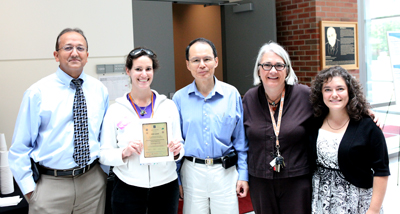
Rashid Bashir, Drew Glaser, Jimmy Hsia, Lizanne DeStefano, and Laura Miller pose with Drew Glaser (University of California, Merced) after presenting her an award for her poster presentation made during the B3SI Poster Session held at the Micro and Nanotechnology Laboratory, University of Illinois."
Regarding his desire to network with other researchers, Gallegos reported: "People there were pretty friendly and willing to share information, so it came kind of naturally. What I have learned lately is that there are a set of main issues in bioengineering that researchers approach in various ways. For example, some try to solve through chemistry, others with electromagnetics. So I put some effort to meet people because I try to know how others are approaching the problems I am also working. As a side effect, I think that meeting people from other places and views enriches me as a world citizen."
According to Miller, the networking should give incoming trainees a head start on their graduate program. "Instead of coming in not knowing anybody, not being familiar with any faculty or any students, they're coming in as part of this traineeship, and their first event is this summer institute." Did networking take place? Miller says, "Yes." New trainees hung out and talked with each other and got to know current trainees. "So that social aspect—that support network got started at the Summer Institute that we hope will be very valuable for those students throughout their career. Instead of coming in blind, they now have a network of faculty and peers. They know each other, and they can all support each other. So becoming part of that group even before they start their fall classes is very valuable."

A trainee conducting a lithography experiment in a cleanroom at the Micro and Nanotechnology Laboratory.
Both Ahmad and Miller indicated that the evaluation being conducted by Lizanne DeStefano and Ayesha Tillman of the I-STEM Education Initiative has been extremely valuable. Stressed Ahmad: "Our job is to see if we are delivering, and that's where the evaluation assessment comes in, in terms of 'What's our goal?' and 'Did we achieve our goals?'"
Miller also recognized the evaluation's importance: "We learn something every time. The evaluation of last year's Summer Institute was so thorough that we were able to make significant changes for this year. And I imagine we'll be able to do that again for next year—find out: What went right? What do we want to keep? What do we want to change?"
The institute also had a distinct international flavor. While most of the participants were from the U.S., twenty were from Taiwan, and one faculty member traveled from Saudia Arabia to attend. The presence of the international contingent was valuable, shared Miller, because "The international perspective can be different and important and really enhance everybody's research."

Two of the Taiwanese participants at work on mechanobiology module in the bioengineering lab.
Ahmad also emphasized the international aspect of the networking, indicating that the Institute created "an environment where you are able to see and meet people whom you would not necessarily meet…where these next-generation-workforce graduate students or postdocs who will go into professional fields would have linkages not only across the US but with researchers all over the world who have a similar interest in the things they would like to do, such as cancer nanotechnology, or such as mechanobiology and the like."
According to Ahmad, we are all responsible for the problems facing our society: "You cannot say this is a developing country problem or a developed country problem. Because of the global connectivity, we are all impacted by an occurrence. Something at another end of the world [impacts] this part of the world and vice versa." He also believes international collaboration is key in solving these problems: "Grand challenges confronting humanity as a society cannot be addressed by a single institution or a single country or a single discipline; these are multi-prong, multi-institution, multi-country problems, just like cancer, energy, environment, water. That means all of the heads have to come together to address these issues."
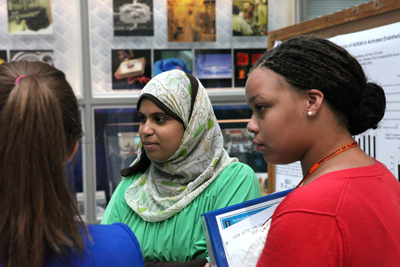
Two trainees listen to another present her research during a poster session.
For more details about the B3SI program and hands-on lab modules, please visit: https://bsbasi-2012.mechse.illinois.edu/index.php.
Story by Elizabeth Innes, Communications Specialist, I-STEM Education Initiative
More: BioE, Grad, MNTL, Summer Research, Undergrad, 2012
Photographs by Obaid Sarvana, nanoHUB.org, and graduate student in Bioengineering.













.jpg)
















